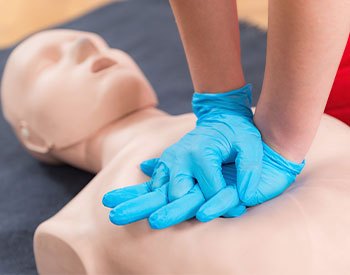702 North Main Street Opp, Al 36467
334-493-3541
Mizell Medical Clinics
Clinic 1 334-493-3240
Clinic 2 334-493-5555
Specialty Clinic 334-493-5704
Elba Healthcare 334-493-5713

First Aid Training - Cardiopulmonary resuscitation. First aid course on cpr dummy.
Cardiopulmonary Services
The Cardiopulmonary Department at Mizell Memorial Hospital provides EKG, 24 and 48 hour Holter Monitor, and cardiac stress testing to patients. They also provide ultrasounds of the heart, carotid arteries, other vasculature. EKG's are done 7 days a week, 24 hours a day with an order form a physician. Other testing is scheduled Monday - Friday by appointment and only with an order from a physician. Specific Procedures are listed below and further information can be read regarding your procedure:
* Electrocardiogram (ECG)
* Holter Monitor
* Cardiac Stress Test
* Echocardiogram (ECHO)
* Nuclear Stress Test
* Carotid Ultrasound
Electrocardiogram (ECG)
An electrocardiogram is used to monitor your heart. Each beat of your heart is triggered by an electrical impulse normally generated from special cells in the upper right chamber of your heart. An electrocardiogram - also called an ECG or EKG - records these electrical signals as they travel through your heart. Your doctor can use an electrocardiogram to look for patterns among these heartbeats and rhythms to diagnose various heart conditions. An electrocardiogram is a noninvasive, painless test. No special preparations are necessary.
Holter Monitor
A Holter monitor is a small, wearable device that records your heart rhythm. You usually wear a Holter monitor for 24 or 48 hours. During that time, the device will record all of your heartbeats. A Holter monitor test is usually performed after a traditional test to check your heart rhythm (electrocardiogram) isn't able to give your doctor enough information about your heart's condition. A Holter monitor has electrodes that are attached to your chest with adhesive and then are connected to a recording device. Your doctor uses information captured on the Holter monitor's recording device to figure out if you have a heart rhythm problem.
Cardiac Stress Test
A cardiac stress test, also called an exercise stress test, is used to gather information about how well your heart works during physical activity. Because exercise makes your heart pump harder and faster than it does during most daily activities, an exercise stress test can reveal problems within your heart that might not be noticeable otherwise. A cardiac stress test involves walking on a treadmill while your heart rhythm, blood pressure and breathing are monitored.
Echocardiogram (ECHO)
An echocardiogram uses sound waves to produce images of your heart which allows the Cardiologist to see how your heart is beating and pumping blood. The Cardiologists can use the images from an echocardiogram to identify various abnormalities in the heart muscle and valves. It gives the Cardiologist information about the size and shape of the heart along with estimates of the heart function such as cardiac output, ejection fraction and diastolic function.
Nuclear Stress Test
A nuclear stress test measures blood flow to your heart muscle both at rest and during stress on the heart. It's performed similarly to a cardiac stress test, but provides images that can show areas of low blood flow through the heart and areas of damaged heart muscle. A nuclear stress test usually involves taking two sets of images of your heart - one set during an exercise stress test while you're exercising on a treadmill or with medication that stresses your heart, and another set while you're at rest. A nuclear stress test is used to gather information about how well your heart works during physical activity and at rest.
Carotid Ultrasound
A Carotid ultrasound is a safe, painless procedure that uses sound waves to examine the structure and function of the carotid arteries in your neck. Carotid arteries deliver blood from your heart to your brain and are located on each side of your neck. Carotid ultrasound is usually used to test for blocked or narrowed carotid arteries, which can indicate an increased risk of stroke.
A technician conducts the test with a small, hand-held device called a transducer. The transducer emits sound waves and records the echo as the waves bounce off tissues, organs and blood cells. A computer translates the echoed sound waves into a live-action image on a monitor. In a Doppler ultrasound, the information about the rate of blood flow is translated into a graph.

